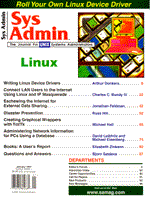
Editor's Forum
What better way to start the year than by saying that it is over? Few would argue against the seemingly blind migration to Microsoft's Windows NT as a major corporate platform. Windows NT 4.0 is, after all, a credible operating system and fulfills most of the promises made back in the Eighties about the functionality of the "next" release of Windows. (Was that supposed to be Windows 2.0 or 3.0?) UNIX, however, is far from dead. Ask any UNIX vendor and you will get a variety of statistics gathered by known and respected analyst firms showing strong UNIX growth in numerous segments of the market. Most of that attention, of course, is focused on markets served by traditional commercial implementations of UNIX. Few areas in the UNIX realm, however, are as lively as Linux, the theme of this month's issue. Born in the often idealistic arena of freeware, and following the free software model largely established by Richard Stallman's GNU project, Linux has become somewhat of a phenomenon. Not only has this freeware re-implementation of the POSIX specifications gained substantial and enthusiastic support within the freeware community, but Linux also has another distinction. It is beginning to gather support from commercial ISVs as well. Numerous commercial application developers now offer versions of their software for Linux - a critical aspect of the success of any operating system. Perhaps even more interesting is the fact that Linux is now available for multiple system architectures. In addition to the original Intel implementation, versions are available for DEC's Alpha and Sun's SPARC architectures. Although I am not sure that I would toss Digital UNIX off an AlphaStation or Solaris off a SPARCstation, platform independence is certainly in keeping with the openness of Linux. From a system administrator's point of view, however, free software often carries a considerable support burden. The time and effort required to maintain and update free software is the trade-off involved with its use. The point at which free software is safe in such an environment is when the package has reached critical mass with respect to support. Within the free software model, that point of critical mass is represented by commercial concerns making a business of providing support and distribution. Cygnus Support (Mountain View, CA) does this for GNU software and is probably a primary reason for commercial use of the gcc compiler. Red Hat Software (Westport, CT) has taken up this mantle for Linux, and has established cooperative relationships with O'Reilly & Associates and the Linux development community as part of their strategy to provide critical mass for Linux. Thus, the Linux issue can be distilled down to a pair of questions. Is it safe to use Linux in a commercial environment? Yes. There is sufficient support beyond the hobbyist/hacker realm on the Internet to make Linux a reasonably safe bet within a business. Should Linux replace all of your commercial UNIX implementations? No. Commercial-grade UNIX from Data General, DEC, Fujitsu-HAL, HP, SGI, Sun and others still are the best choice for various systems and applications. The Linux free software model, however, does provide an intriguing alternative for some purposes.
Sincerely yours,
|